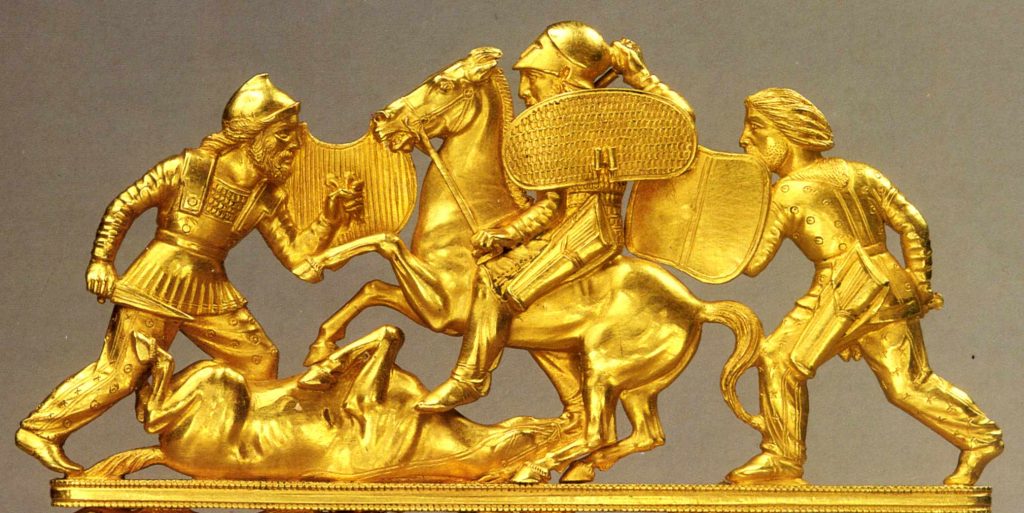A true masterpiece of Scythian metalwork, an extraordinary Gold Comb crested with fighting Scythians was discovered in Solokha Royal Kurgan in Zaporizhzhia region of Ukraine on the left bank of the Dnieper River in 1912. The Solokha kurgan dating to the 5th centiry B.C., not far from the town of Nikopol was 18 meters high (58.5 ft.) and concealed two vaults; in one of them, was found a woman of high birth in rich attire. The second vault contained the body of a Scythian warlord-king, his weapon-bearer, a servant, five horses, and a stableman. The head of the dead chief was covered with a heavy bronze helmet; gold rings and bracelets adorned his arms, and around his neck was a gold, crescent-shaped ornament (Solokha gryvna). The splendor of the attire, embroidered with gold plaques, was further heightened by an iron sword in a gold sheath and a delicately wrought gold phiale – a symbol of power. The comb, the only relic of antique jewelry of its kind lay beside the chief’s head. Some historians believe that it was Scythian King Octamacades who was buried in Solokha Kurgan. The King is known to history thanks to Herodotus who described him as the ruler who killed his brother Skyles for betrayal of the Scythian faith for the sake of the Greek beliefs: “Afterward, Skyles marched back home, where the Scythians had revolted and had chosen his brother Octamasades, the son of Teras’ daughter, to be their leader. When Skyles learned what was happening and the reason for it, he fled to Thrace. Upon hearing of this, Octamasades launched an expedition against Thrace, but when he reached the Ister [Danube], he found the Thracians there prepared to oppose him. Just as they were about to join battle, however, Sitalkes sent this message to Octamasades: “Why should we make a trial of our strength in battle? After all, you are the son of my sister, and you hold my brother. Give my brother back to me, and I will hand over your brother Skyles to you. That way neither you nor I will endanger our troops.” That was the message Sitalkes sent and had proclaimed, for the brother of Sitalkes had in fact fled from him and had found refuge with Octamasades. Octamasades approved this suggestion and gave up his maternal uncle to Sitalkes, receiving his brother Skyles in return. When Sitalkes got his brother back, he took him away with him, while Octamasades had Skyles beheaded on that very spot. So that is how protectively the Scythians uphold their own customs, and such are the penalties they exact on those who deviate from them by taking up foreign customs.” {Herodotus, 4:80)
Comment: The common notion that the Scythians received their gods from the Greeks is debunked by this very passage by the most trustworthy historian of the 5th century B.C. It was the other way around.
The Gold Comb from the Solokha Royal Barrow weighs 294.1 grams (10 ounces) and has nineteen tetrahedral teeth above which runs a frieze formed by the figures of reclining lions. It is 12.3 x 10.2 cm and is made of pure gold and is currently in Hermitage.

The frieze is surmounted by a sculptural group: a horseman, accompanied by a lightly armed foot soldier, attacks his enemy who has dismounted because his wounded horse was fatally wounded and is lying under the feet of the fighting men. The outward appearance of the Scythian warriors, their clothes, and their weapons are reproduced with incredible accuracy. Here is how the Comb was used to study Scythian trousers for example >
Famous Scythologist and Dr. of History Anastasia Mantsevich (1899-1982) in her book “Kurgan Solokha” wrote that the bronze helmet found on the head of the Scythian warlord buried in Solokha kurgan resembled the helmet on the head of the horserider on the Solokha comb. A short-sleeved tunic covered with iron scales resembling the one on the horserider was found at the entrance to the chamber. There were also the bronze greaves nearby. Adding to these three coincidences the fact that the comb was placed near the head of the deceased, the author of this article finds it logical to conjecture that it was most likely the very person represented as the horserider on the comb who was buried in the second Solokha chamber. You can take a closer look at the central figure of the composition in the image above. This supposition would explain why the horse-rider is portrayed with his helmet not covering his face during the battle. When one comes to think of it, wearing a bronze helmet the way it is shown would be very inconvenient and very dangerous – apart from the obvious threat to receive a blow to the open face, the helmet could shift, and could fall distracting a fighter at the most crucial moment. The most obvious reason why an artist would want to represent someone with a helmet in such a position, would be if he or she wanted to show the fighter’s face. This could also explain why the comb was placed close to the face of the deceased warrior king – so that people could see and compare. Also, after the resurrection, the warrior would “wake up”, take the comb and remember his previous life instantly. The Scythians believed in the resurrection centuries before the Christian era – for details see “Royal Scythia, Greece, Kyiv Rus” book. The book also presents a deity that the Greeks ‘borrowed’ from the Scythians.